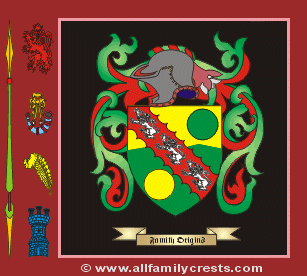|
     
Heraldry is the practice of designing, displaying, describing and recording coats of arms and badges, as well as the formal ceremonies and laws that regulate the use and inheritance of arms. The origins of heraldry lie in the need to distinguish participants in battles or jousts, whose faces were hidden by steel helmets. In the U.S., the word "crest" is commonly used to refer to a coat-of-arms. However, in heraldry, a crest is just one component of a complete achievement of arms. The crest sits on top of a helmet, which itself sits on the main and most recognizable part of the arms, the shield or escutcheon. Other elements may include supporters holding up the shield and a motto beneath. Crests can in fact be used on their own (this is particularly useful when there is insufficient space to display the entire coat-of-arms); but where the shield alone is used it should never be called a "crest". Heraldry - Wikipedia, the free encyclopedia |
|
    
The knights in the Bayeux Tapestry from the late eleventh century carry no coats of arms, yet by the mid twelfth century personal badges were being used widely by nobility. By the reign of Henry III of England, arms were inherited, thus their judicial regulation became important. The practice of using marks of cadency arose, to distinguish one son from another, and was institutionalized and standardized by the fifteenth century. In the late Middle Ages and Renaissance, heraldry became a highly developed discipline, regulated by professional heralds. As its use in jousts became obsolete (with the exception of rare revivals), arms remained popular for visually identifying a person in other ways — impressed in sealing wax on official documents, carved on a family tomb, and so forth. The first work of heraldic jurisprudence, De Insigniis et Armiis was written by a professor of law at the University of Padua, Bartolo of Sassoferrato, in the 1350s.
- "Bartolo's book became popular in legal circles, but most heralds and knights did not speak the Latinate jargon in which De Insigniis et Armiis was written. Because of this linguistic divide, the field of heraldic law bifurcated. One was vernacular, and includes the works of Honoré Bonet and Christine de Pisan. The other remained in Latin, and, in Wales and England, is represented by the works of De Bado Aureo and Upton. This Latin continuation of heraldic legal thought spawned, in England, other vernacular heraldic texts, which are the direct antecedents of Tudor and modern studies of heraldry" (C. Levin)
Throughout the existence of heraldry, coats of arms have been executed in a wide variety of media, including painted wood, embroidery, enamel, stonework, stained glass and, later, computerised media. For this reason, and because its original function was quick recognition in the chaotic conditions of battle, heraldry for the most part distinguishes only six tinctures (yellow, white, red, blue, black and green; purple is counted in theory but its use in practice is marginal) and makes no fine distinctions in the precise size or placement of charges on the field, or the number of a lion's claws. Coats of arms and their accessories are described in a concise jargon called blazon, which for the most part ignores details that are conventional, and in nearly all cases details of varying artistic depictions, which tend to be small and not to help quick visual distinction. It should be noted that the property interest, if any is recognised, in the coat-of-arms inheres in the blazon and not in the particular depiction of the arms. It is sometimes said that each element of a coat of arms has a conventional meaning, that white stands for honour, blue for loyalty and red for courage, and so on. While the original bearer of a coat may well have had some symbolism in mind, there is no reason to expect consistency from one to the next. In general it is impossible to say what a given coat of arms "means", unless, as is often the case, it incorporates a pun on the bearer's name. The development of portable firearms made plate armor nearly useless, and heraldry, detached from its original function, gradually became more elaborate at the expense of clarity, both in content (e.g., landscapes representing battle sites became frequent in the 18th century) and in presentation (rococo frames overwhelming the content of the shield). The 20th century's taste for stark iconic emblems made the simple styles of early heraldry fashionable again. Heraldry - Wikipedia, the free encyclopedia     
More on Heraldry coming in the next few weeks!! |










